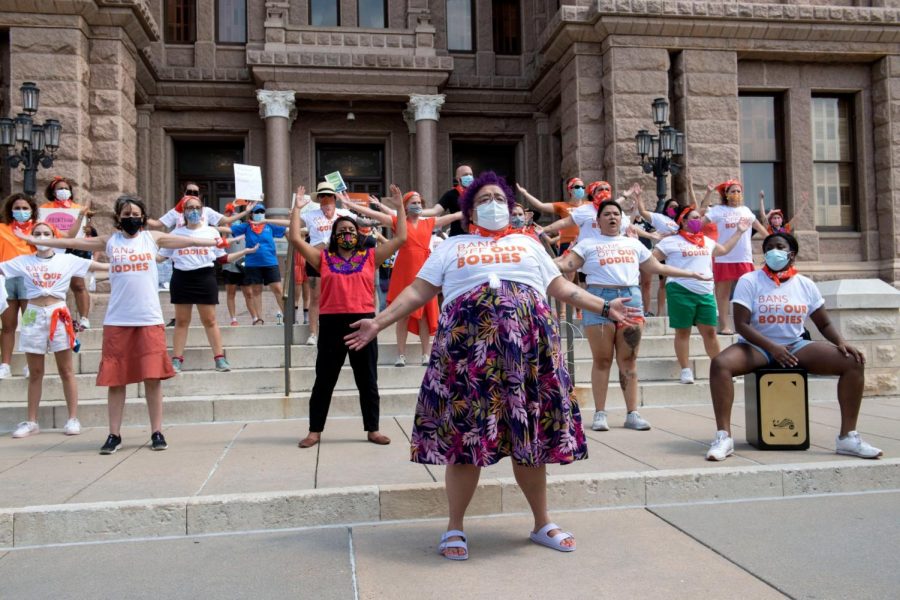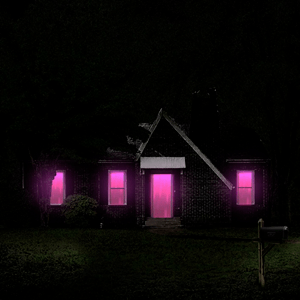The six week deadline: everything to know about the new Texas abortion bill
Credit: John Anderson/The Austin Chronicle
A protest is performed against Texas’ new Heartbeat bill in front of the Texas Capitol on September 1, 2021.
September 28, 2021
People gather outside the outside the Texas State Capitol on sunny September 1, some are holding signs with words like “we demand bodily autonomy” or “abortion is healthcare,” but all of them are chanting, “Bans off our bodies, my body is my own.”
Texas’ new law came into effect on September 1, 2021. It enables any and all persons, as long as they are not an officer or work for the state or government, to act as a vigilante of sorts by filing lawsuits against medical practices or people who help or plan to help a pregnant women get an abortion once the unborn fetus’ heartbeat is detected, which can be “as early as 3 weeks after conception or 5 to 6 weeks after the first day of the last menstrual cycle,” according to Dr. Vincenzo Berghella, director of maternal-fetal medicine at BabyCenter.
“In Texas, we work to save those [children’s] lives, that’s exactly what the Texas legislature did this session.” said Greg Abbott, the Governor of Texas in a video he posted on his Twitter where he signed the bill. “They worked together on a bi-partisan basis to pass a bill that I am about to sign that insures that the life of every unborn child who has a heartbeat will be saved from the ravages of abortion,”
With this law in place any citizen of the state can sue someone if they help provide an abortion. “The patient may not be sued,” said writers Adam Liptak, J. David Goodman, and Sabrina Tavernise in the article Supreme Court, Breaking Silence, Won’t Block Texas Abortion Law, “but doctors, staff members at clinics, counselors, people who help pay for the procedure, and even an Uber driver taking a patient to an abortion clinic are all potential defendants.”Only the patient who the abortion is being performed on may not be sued.
Alan Feuer in the article The Texas Abortion Law Creates A Kind of Bounty Hunter. Here’s How It Works from the New York Times said, “The law establishes a kind of bounty system. If these vigilante plaintiffs are successful, the law allows them to collect cash judgments of $10,000 — and their legal fees — from those they sue. If they lose, they do not have to pay the defendants’ legal costs.”
Since it’s passing, the law has sparked controversy leading to things such as protests for women’s rights, like one that happened in front of Texas’s state capitol the day the law went into effect. Based on the Latin American feminist performance protest ‘The Rapist In Your Path’ also known as ‘The Rapist Is You,’ the protesters were wearing either orange or white, with shirts that said “Bans off our bodies.”
A meme circling social media also portrayed the Dallas Cowboys cheerleaders participating in another form of protest. The cheerleaders had on an edited blue version of the outfit worn by women in the popular Hulu show “The Handmaid’s Tale.” The outfits in the show are worn by Handmaids and symbolize ‘lifeblood’ because the handmaid’s duty is to reproduce.
Politicians and celebrities also spoke out against the abortion law, using their platforms to voice their opinions about the new law.
In agreement with the law, Lieutenant Governor of Texas, Dan Patrick tweeted, “Human life is sacred & should be protected at all stages. Now officially in effect, the Heartbeat Bill bans abortions as early as 6 weeks or when a heartbeat is detected. #SB8 is a victory for life & demonstrates our commitment to protecting our most vulnerable. #txlege #ProLife”
Human life is sacred & should be protected at all stages. Now officially in effect, the Heartbeat Bill bans abortions as early as 6 weeks or when a heartbeat is detected. #SB8 is a victory for life & demonstrates our commitment to protecting our most vulnerable.#txlege #ProLife pic.twitter.com/ROYek8DScw
— Dan Patrick (@DanPatrick) September 1, 2021
Disagreeing with the law, “Last night, the Supreme Court officially overturned five decades of settled law and permitted Texas’ unconstitutional abortion ban to stand,” former United States Secretary of State, Hillary Clinton, tweeted, “Yes: They gutted Roe v. Wade without hearing arguments, in a one-paragraph, unsigned 5-4 opinion issued in the middle of the night.”
Last night, the Supreme Court officially overturned five decades of settled law and permitted Texas’ unconstitutional abortion ban to stand.
Yes: They gutted Roe v. Wade without hearing arguments, in a one-paragraph, unsigned 5-4 opinion issued in the middle of the night.
— Hillary Clinton (@HillaryClinton) September 2, 2021
On September 1st, 2021 after an emergency appeal from both abortion providers and people who wanted to block the new law, a Supreme Court meeting was called in the late hours of the evening wherein the members of the court voted 5-4 in denying the blocking of the new law, leading to another wave of anger.
American actress and stand-up comedian Amy Schumer tweeted, “The newest Texas abortion ban, #SB8, gives politicians, neighbors, and even strangers the right to sue those who provide – or just help patients get – abortion after 6 wks. The time to fight for our reproductive health & rights is now! #BansOffOurBodies ppact.io/sb8”
The newest Texas abortion ban, #SB8, gives politicians, neighbors, and even strangers the right to sue those who provide — or just help patients get — abortion after 6 wks. The time to fight for our reproductive health & rights is now! #BansOffOurBodies https://t.co/Yhoxll4piP
— Amy Schumer (@amyschumer) September 1, 2021
In an official statement, President Joe Biden called the Court’s ruling, “an unprecedented assault on a woman’s constitutional rights under Roe v. Wade, which has been the law of the land for almost fifty years.”
Supreme Court Chief Justice John Roberts, dissenting on the case said, “The Court’s order is emphatic in making clear that it cannot be understood as sustaining the constitutionality of the law at issue. But although the Court does not address the constitutionality of this law, it can of course promptly do so when that question is properly presented.”
In simpler terms: the law might or might not be constitutional and the Court members aren’t deciding that at this time though they might in the future if the right case is presented and argued.
After the court case, more protests happened. One on Monday, September 13 took place outside of Supreme Court Justice Brett Kavanaugh’s home in Chevy Chase, Maryland calling for Kavanaugh to resign after he ruled in favour of Texas’ law.
Because this law was not blocked by the Supreme Court, it will set a new standard for how far policies can be pushed before they can be declared unconstitutional.












